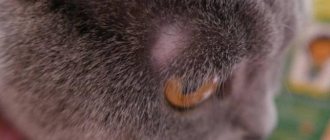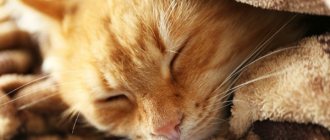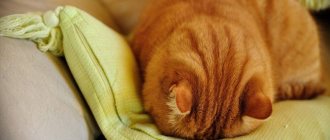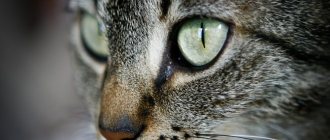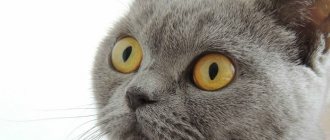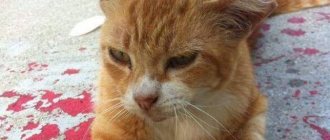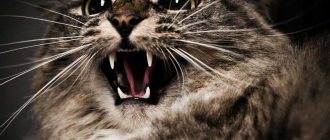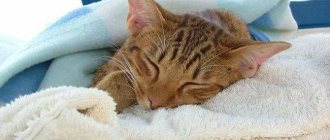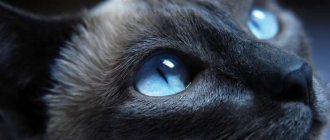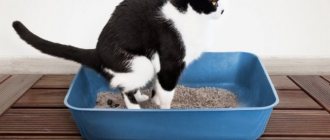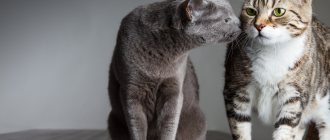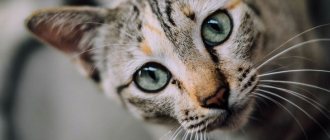8413Administration
3
Urinary incontinence in a cat, which owners often perceive as hooliganism on the part of the animal, is actually a sign of a health problem in a furry or hairless pet. To eliminate this unpleasant phenomenon, the cat must receive high-quality medical care, for which it should be shown to a veterinarian. If this is not done, the disease that caused the incontinence will continue to progress and may lead to the death of the sick cat. Provided that therapy begins in a timely manner, the likelihood that the problem will be eliminated completely is very high.
A cat has urinary incontinence: 6 main reasons
Urinary incontinence in cats, otherwise known as incontinence, occurs for the following reasons:
- Spinal injuries. They occur as a result of falling from a height or being bitten by a dog. Alternatively, tumors in the immediate vicinity of the spinal cord.
- Obesity develops in domestic cats as a result of adynamia. Neutered men suffer most often.
- Cystitis is inflammation of the bladder. They develop when an infection enters the urinary tract.
- Urolithiasis (UCD) occurs as a result of cystitis or metabolic disorders, mainly in cats due to the peculiarities of the anatomical structure of the urinary canal. The main reason is poor nutrition combined with hypothermia.
- Kidney pathologies. Typical for older animals.
- Diabetes.
Examination by a veterinarian
Kurilian bobtail, with documents and vaccinations, took a one-year-old, according to the advertisement. Since her arrival, she has been constantly diarrhea, the stool is brown, liquid, homogeneous without pieces, the consistency of thin sour cream, after a couple of weeks droplets of feces began to fall out when walking... the smell is very fetid... plus increased gas formation - we begin to massage the stomach - farts.
At the same time, his appetite is good, he is gaining weight, there is no vomiting, and he behaves actively. Within a week, the third eyelid fell out, but soon it passed. We put her on a rice diet with chicken meat (2 weeks) - her stool did not return to normal. We began to suspect a viral origin - soon our kitten, who was doing fine before her arrival, also began to diarrhea.
Injected with gamavit fosprenil - no changes in the cat, the kitten's diarrhea went away. We tried to inject the antibiotic tylosin - the stool began to lose even more, the stool acquired a dark green color (a week). Only after a two-day hunger strike was the stool more or less formed. The primary concern is incontinence - what could this be connected with? Of course, I would like to normalize the stool. And if you go to the clinic, what tests need to be taken in this situation?
The doctor needs to tell all the symptoms that the owner noticed. During the examination, the veterinarian will perform palpation, which can be used to identify large tumors and organ development abnormalities.
We invite you to read: Characteristics of the British Shorthair cat: playfulness, aggression, compatibility with children
In case of incontinence and other urological disorders, a urine test will be prescribed, most often microscopy of the sediment will be required. Previously, we have already given a detailed explanation of a urine test for a cat. If necessary, ultrasound and x-rays are also performed.
Additional studies may be needed, such as a blood test, microflora culture, and analysis of renal epithelium in the cat’s urine.
Important: obvious neurogenic disorders such as injuries, tumors, spinal hernias, and urinary disorders are treated by eliminating these factors.
In cases of functional disorders, a complete and comprehensive examination cannot be avoided. Only a complete collection of all indicators will make it possible to correctly diagnose and correctly prescribe treatment.
During the examination, the veterinarian will recommend using special diapers for animals. There should always be a clean, absorbent diaper on the sleeping area. These care items are sold at any pet store.
Important: do not scold your pet for its inability to tolerate, do not punish it under any circumstances. A stressful situation will only harm the animal, but affection and care, on the contrary, will help cope with the disease.
Types of urinary incontinence in cats
There are the following types of urinary incontinence in cats:
- Leakage : The sphincter fails to control the flow of urine. Urine constantly flows or is released in drops. They are absorbed into the carpet or sofa fabric and are invisible. Pathology is detected by the presence of an ammonia odor. The intensity of the leakage increases when the animal moves.
- Stress : joy or fear is accompanied by involuntary urination.
- Urinary urgency occurs suddenly. The animal does not have time to get to the tray, worries that an embarrassment has happened to it, but is unable to do anything.
Be sure to read:
The kitten has bad breath: reasons, what to do, when it is an alarming symptom, prevention
Preventive measures
In order to prevent the occurrence of enuresis in a pet, it is important to exclude all factors and causes that have a positive effect on the development of this pathology. It is important to feed your cat properly and prevent injuries, falls and bruises. There should be no drafts or excessively low temperatures in the room where the cat is located.
Systematic examinations by a veterinarian for preventive purposes are the best way to prevent urinary incontinence and any other disease in a pet.
What to do if your cat has urinary incontinence?
Sometimes urinary incontinence occurs as a postpartum complication. The pathology resolves spontaneously. In all other situations, if incontinence is suspected, the cat is sent to the clinic for examination.
The veterinarian conducts an examination, takes blood for analysis, performs an ultrasound, makes a diagnosis and prescribes treatment. If surgery is indicated, it is performed in a clinic, and postoperative care is provided by the animal owner at home. If conservative treatment is required, follow the procedures prescribed by the veterinarian.
With urolithiasis, situations arise when it is necessary to insert a catheter to drain urine. If your cat is diagnosed with diabetes, you will need insulin therapy and a special diet that is low in carbohydrates and high in protein and fat.
Diagnostics in a veterinary clinic
To make a diagnosis, the veterinarian, in addition to a visual examination of the animal and anamnesis, conducts a number of diagnostic studies. These include urine analysis, blood biochemistry, pelvic x-ray, and urological ultrasound. Sometimes additional diagnostic methods are used.
Urine for analysis must be collected correctly, otherwise feces caught in the urine may affect the results of the study.
It is advisable that the material for analysis be taken directly by a specialist.
Urinary incontinence in cats: treatment at home
Recovery after surgery consists of treating surgical sutures and a gentle diet. Conservative treatment consists of eliminating the underlying disease. The therapeutic strategy includes dietary therapy and drug treatment.
Correcting the diet eliminates factors that provoke urinary tract irritation. All human food products are excluded, as well as treats containing waste from cutting meat and fish.
The veterinarian will tell you when you can adjust the composition of the natural diet, and in which cases you can use ready-made dietary food. In some cases, therapeutic nutrition is carried out until the clinical symptoms disappear, but sometimes lifelong use of ready-made dietary feeds will be required.
Medications
Medicines are used to eliminate the symptoms of the underlying disease.
The following groups of medicines are in demand:
- antibiotics;
- antispasmodics;
- anti-inflammatory drugs;
- analgesics;
- means that normalize the functioning of the sphincters and bladder.
Be sure to read:
A cat vomits hair: reasons, what to do, medications and folk remedies, prevention
To improve the well-being of elderly animals with chronic renal failure, the oral drug Semintra or analogs are prescribed.
Folk remedies
There are no traditional medicines that can have a positive effect in the treatment of urinary incontinence. However, the many years of experience of connoisseurs of medicinal herbs have been taken into account and, on its basis, drugs have been developed that are used in medicine and veterinary medicine. Urolex contains birch leaves; bearberry. goldenrod, horsetail.
The drug is used to treat urolithiasis, as well as inflammatory processes of the urinary tract 3 times a day for a month. The drugs Kot Erwin and Stop-Cystitis have a similar effect.
Medicines developed on the basis of traditional medicine can be used after consultation with a veterinarian.
Treatment method and prognosis
Ultrasound diagnostics is mandatory when examining a cat.
The cause of incontinence is determined by a qualified professional based on medical history, clinical signs and laboratory tests. If necessary, an ultrasound of the bladder, a biochemical blood test and an x-ray of the pelvic area are additionally performed. If your pet has spinal injuries, it is strongly recommended to undergo an examination by a neurologist.
In case of involuntary urine discharge, complex treatment is carried out. The scheme is drawn up individually, depending on the cause of the pathology, age, and condition of the animal.
The main treatment methods include:
- Antibiotic therapy. Relevant for identifying infections and bacteria in the genitourinary system. The drug is administered intramuscularly or intravenously.
- The use of medications to normalize metabolic processes in the body.
- Special diet (if the pet is overweight).
- Antispasmodics and painkillers (for urolithiasis).
- Drugs that strengthen the tone of the bladder walls and stimulate the activity of the sphincter.
The prognosis depends on the disease. So, if incontinence is associated with an infection in the body, then after appropriate treatment it goes away.
Unfortunately, in some cases it is no longer possible to get rid of this unpleasant disease. If the cat is old, then its weakened body cannot adequately respond to therapeutic measures. In addition, the tissues are not restored and rejuvenated, so urine will leak constantly and its volume will increase.
The only thing that remains for the owner to do is to come to terms with it and provide the pet with the most comfortable living conditions. You can place trays in different places in the apartment or put a diaper on the cat.
Preventing urinary incontinence in cats
Preventing pathology involves following the rules for keeping and feeding a cat. There should be no drafts in the room. The cat should not be bathed frequently, and if such a need arises, it should be thoroughly dried and allowed to dry before being released indoors.
It is necessary to decide on feeding - natural or ready-made food. You cannot alternately feed both. If you decide to change the type of feeding, this should be done gradually, over the course of a week.
The use of economy-class feeds unbalanced in amino acids and vitamins accelerates the development of chronic diseases that lead to inflammatory processes in the genitourinary area and urinary incontinence. Therefore, it is necessary to use ready-made food of at least premium class. The use of canned food and granules can be alternated.
Neutered animals should be fed prepared food for sterilized cats. Excess gonads alter metabolic processes and increase susceptibility to the formation of urinary stones. Sterilization at an early age causes the urinary ducts to stop growing and they remain narrow.
If urate salt precipitates, a grain of sand is formed. In animals with a normal width of the ureter, it skips. With a narrowed lumen, the stone gets stuck. An obstruction to the outflow of urine is formed. Urolithiasis (urolithiasis) develops.
Be sure to read:
A cat has diarrhea and vomiting: what to do at home, reasons, what can be given, what to feed
Additional diagnostics will be required to prescribe treatment. If struvite stones have formed, urine acidifying foods will be required. When oxalate stones are detected, the urine must be alkalized by selecting feed. Cats are transferred to specially developed medicinal food.
For pets predisposed to KSD, it is recommended to use bottled still water for drinking. Treats from the table must be stopped. Products that are unusual for cats contain substances that provoke the development of chronic diseases.
Obese cats are transferred to ready-made dietary food. If you limit the consumption of natural food, your pet will feel hungry and scream, begging for food. Diets for overweight animals contain a high percentage of dietary fiber, which limits consumption. The pet's body will receive fewer calories, but the animal will feel full.
Medicinal food has been developed for cats suffering from kidney disease, diabetes, and urolithiasis. However, a cat cannot be protected from one disease. This is old age. Older pets are switched to specialized food that allows them to feel satisfactory.
